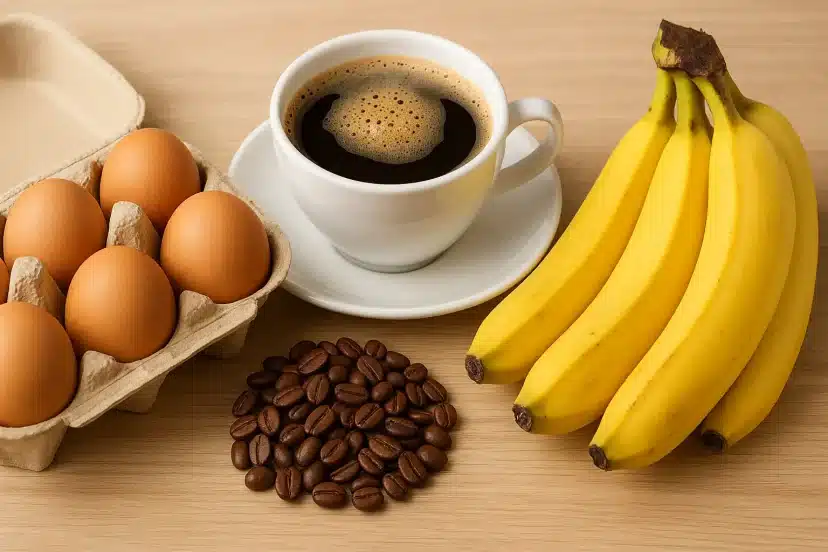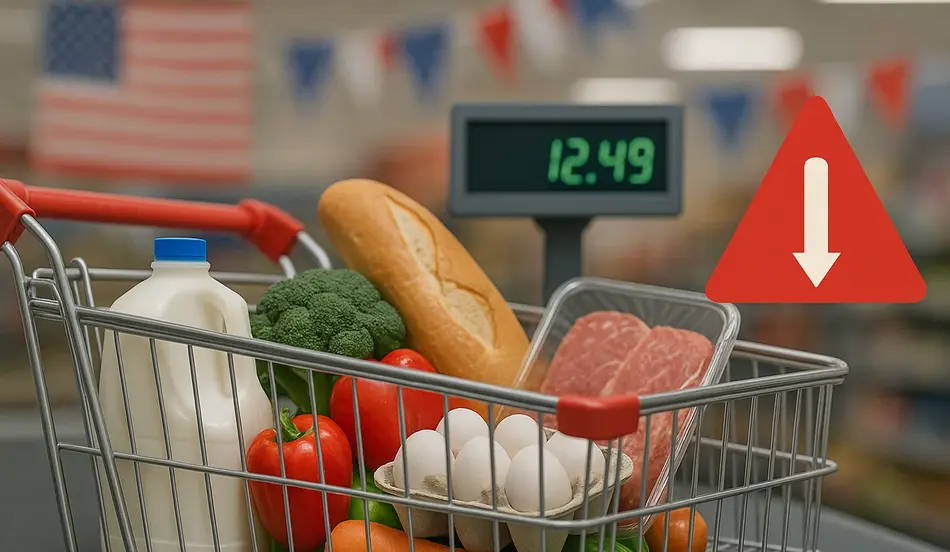U.S. Grocery Prices 2025 remain steady in July, according to the latest Consumer Price Index (CPI). Inflation in grocery costs held flat compared to the previous month but rose 2.9% year over year. While that increase may seem modest, the strain on household budgets remains significant. Recent polling shows that more than half of Americans—53%—list grocery costs as a major source of financial stress.
To understand how those numbers translate to everyday shopping, we spoke with Stew Leonard Jr., president of Stew Leonard’s grocery chain, who outlined the items driving price pressures, the effects of international tariffs, and how customers are changing the way they shop.
Table of Contents
Why Beef Is the Biggest Pressure Point in U.S. Grocery Prices 2025
For many households, summer grilling season means burgers, steaks, and ribs. But meat prices, especially beef, are climbing rapidly. Leonard pointed to ribeye steaks as a prime example.
“We’re at a historic low herd size in America, so the supply is very low and prices have picked up,” Leonard said. “Our beef buyer told me this morning he’s already seeing signs that prices could rise by 80 cents to a dollar a pound heading into the holidays.”
Cattle herds are at their smallest in decades, driven by droughts, rising feed costs, and ranchers reducing stock during the pandemic years. With reduced supply and steady demand, prices are unlikely to ease in the short term.
Shrimp and Seafood: Tariffs Rewrite the Menu
Seafood, a signature item for Stew Leonard’s stores, is also under strain. The company moves more than half a million pounds of shrimp per year, but international tariffs have reshaped sourcing.
- Shrimp from India now faces tariffs of up to 50%, making it prohibitively expensive.
- Ecuador’s shrimp, taxed at 15%, has become the alternative.
“Right now, we’re moving our production over to Ecuador,” Leonard explained. “It’s a huge shift for us.”
There is some good news for seafood lovers: lobster prices have come down. Exports to China have slowed, leaving more supply available domestically. U.S. shoppers may benefit during the holidays with lower lobster costs, even as other proteins climb.
Eggs, Coffee, and Bananas: Everyday Staples in Flux
While eggs have finally stabilized after last year’s avian flu crisis sent prices soaring, other staples remain volatile.
- Coffee prices are climbing, driven by heat waves and weather disruptions in major coffee-producing countries.
- Bananas, which the U.S. does not produce domestically, carry a 15% tariff from Costa Rica. So far, importers are absorbing the extra costs, but Leonard warns that those buffers won’t last forever.
“Our importers are eating that tariff right now,” he said. “They haven’t raised prices yet, but inventories are running out. By next month or October, we’ll hit a critical point that determines holiday food prices.”

How Tariffs Are Reshaping Grocery Costs
The broader issue, Leonard emphasized, is tariffs. From shrimp to bananas, aluminum trays to imported wines, the added costs ripple through supply chains.
- European wines such as Bordeaux and Barolo are already subject to tariffs. Suppliers stocked up inventories earlier this year, but those reserves are nearly depleted.
- Imported produce faces added duties, which grocery chains can only absorb for so long.
“We’ve been here 50 years, and we’ve always worked on thin margins,” Leonard said. “People have to eat, so we’ll always have sales. But if tariffs stay this high, especially at 25% or 50%, we simply can’t absorb all of it.”
This balancing act—protecting family budgets while weathering international trade tensions—is the new reality for American grocers.
Consumer Habits: More Cautious, More Strategic
If the price pressures are mounting, how are consumers responding? Leonard sees subtle but clear shifts in shopper behavior.
- Digital apps: More customers are using the Stew Leonard’s app to track weekly specials and discounts. “We’ve noticed app purchases of sale items are way up,” Leonard said.
- Private labels: Store-brand products are growing in popularity as shoppers seek savings without sacrificing quality.
- Sampling less effective: In-store demos, once a reliable driver of sales, no longer produce the same spikes. “People aren’t lingering,” Leonard said. “They’re focused, more price-conscious, grabbing what’s affordable and moving on.”
Still, he stressed that customers are not cutting corners on freshness or quality. “They’re not buying day-old or expired goods. They want fresh food, but they’re more careful about where every dollar goes.”
Hire Talent That Understands Today’s Consumer
Post your job on WhatJobs and connect with retail, marketing, and supply chain professionals who know how to adapt to cautious, value-driven shoppers.
Post a Job Now →What to Expect for the Holidays
The real test, Leonard warned, will come during the holiday season. With tariffs weighing heavily on imports, beef herds still low, and coffee and produce supplies uncertain, prices could shift quickly.
“If this tariff situation isn’t worked out soon, families are going to feel it in their holiday grocery bills,” he said. “By next month, we’ll know whether retailers can hold the line or not.”
For families, that means preparing for both possibilities: stable prices if trade talks succeed, or noticeable hikes if tariffs remain.
A Balancing Act for Grocers
Stew Leonard’s, like many family-run grocers, faces the challenge of maintaining customer trust while managing razor-thin margins. Leonard pointed to his decision to keep ground beef at $3.99 per pound—a loss leader meant to give families affordable access to burgers during summer grilling season.
That kind of price restraint, he said, can’t last forever if costs continue rising. “We don’t want to raise prices. But as a family business, there’s only so much we can absorb.”
A Lighter Note
Amid the serious discussion of tariffs and inflation, Leonard shared a more personal update: he’s throwing the ceremonial first pitch at Yankee Stadium. With coaching tips from Bon Jovi, Willie Randolph, and Martha Stewart, he admitted the pressure is on.
“I can’t throw a ground ball,” Leonard laughed. “Otherwise the whole stadium boos.”
The Bottom Line
For now, grocery prices may appear steady, but the calm could be short-lived. With tariffs tightening supply chains and key products like beef, coffee, and bananas facing pressure, the fall and holiday seasons will be critical in determining whether shoppers face another round of sticker shock.
Grocers like Stew Leonard’s are working to cushion the impact where possible, but Leonard’s message is clear: unless trade disputes ease, families should brace for higher costs ahead.
FAQ: Grocery Prices and Tariffs
1. Why are beef prices rising so quickly?
Beef herds in the U.S. are at their lowest in decades due to drought, high feed costs, and herd reductions during the pandemic. With supply down and demand steady, prices are climbing and could rise further heading into the holidays.
2. Which foods are most affected by tariffs right now?
Shrimp (especially from India), bananas from Costa Rica, European wines, and imported aluminum products are seeing the heaviest impact. Tariffs of 15%–50% are forcing grocers to change suppliers or absorb costs.
3. Are grocery stores raising prices yet?
Many stores, including Stew Leonard’s, are holding prices steady for now by absorbing some tariff costs. However, with inventories running low, grocers warn that price increases could appear as early as fall 2025 unless trade disputes are resolved.
4. How are consumers adapting to higher grocery costs?
Shoppers are relying more on store apps for specials, switching to private-label products, and becoming more selective in what they buy. While still prioritizing fresh, high-quality food, customers are showing heightened price sensitivity.




